
Controversial new report argues that postal banking could help the underserved while boosting revenues.
As the U.S. Postal Service (USPS) continues to suffer financial losses, many new proposals have emerged to provide the revenue boost the agency needs. But in recent weeks, one controversial proposal calls for allowing the USPS to bring in revenue by entering the business of postal banking.
A new white paper released by the USPS Office Inspector General (OIG) proposes that the nation’s post office begin offering a range of non-bank financial services to its customers. Suggested services include reloadable prepaid cards, online bill payment, and even small loans. By offering this new suite of financial services, the OIG argues that the USPS could tap into a new source of revenue while also assisting communities currently underserved by banks.
Today, as brick-and-mortar banks struggle to sustain branches in low-income neighborhoods, up to 34 million Americans may be classified as “unbanked”—meaning that they have no checking or savings account—or “underbanked,”— meaning that they are largely excluded from the traditional banking system.
According to data collected by the Federal Deposit Insurance Corporation, 28 percent of Americans live in communities underserved by the traditional banking system.
The recent OIG paper suggests that when Americans have no access to conventional financial services—particularly credit-based financial products—they frequently turn to exceedingly expensive forms of non-bank financing, such as payday loans and check cashing. Products like payday loans and car title loans typically carry exorbitant fees, sometimes charging fees equivalent to an annual interest rate of 391 percent. Such non-bank financing can undermine the financial stability of individuals who are underbanked and further exclude them from the world of digital banking.
The nation’s post offices, the OIG argues, are well-positioned to address underserved communities. While the underbanked may not have access to neighborhood banking locations, supporters of the white paper proposal emphasize the ubiquity of the USPS—nearly every American lives in close proximity to one of the nation’s 35,000 post offices. Crucially, according to the OIG, nearly 60 percent of these post offices are located in a zip code with no brick-and-mortar bank. In addition to post offices’ accessibility, the OIG suggests that the USPS is also well-suited to offer financial services because of its trustworthy reputation and familiarity, traits which can facilitate the development of helpful financial relationships with the underbanked.
Senator Elizabeth Warren (D-MA) has called the OIG’s proposal “innovative,” but the Postal Service actually has a history of providing financial services. From 1911 until 1967, the post offices accepted savings deposits through its prevalent Postal Savings Program, although the program was ultimately discontinued after a drop in popularity. Today, the USPS enjoys 70 percent market share of domestic paper money orders in the United States, a service that brought in over $166 million in revenues to the USPS in 2012. The USPS also offers international money orders, provides a limited amount international remittance services, and it sells prepaid gift cards to major retailers.
Senator Warren suggests that if it began to offer a broader suite of financial services—“nothing fancy, just basic bill paying, check cashing and small dollar loans”—the USPS could improve its financial outlook while providing “access to affordable and fair financial services” for underbanked Americans.
Supporters of the OIG proposal cite the experience of postal agencies in other countries, where offerings of financial services have boosted revenues in the face of declining mail volumes.
While the OIG’s proposal has gained some measure of support, it has also sparked some criticism from within the banking industry. Critics view the proposal as a governmental attempt to create a “new [government-sponsored entity] engaged in banking services, which is not subject to the same level of regulation” as banks.
The OIG argues that, instead of competing with banks, the USPS should seek to partner with banks in order to provide this new suite of services.
Other commentators have questioned the profitability of providing financial services, particularly considering the USPS’s relative lack of experience in the financial industry. Given the projected learning curve of such a new initiative, Professor Rick Geddes asks, “Would this be an additional drain or could the Postal Service do this in a way that would make it profitable?” Economist Adam Ozimek asserts that the pursuit of postal banking would fail to bring in projected revenues and would effectively “solidif[y] the too-big-to-fail status of the USPS.”
The USPS has not yet endorsed the white paper’s conclusion, but has indicated that it is currently reviewing the proposal.



